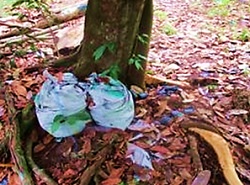Phytochemical and Cytotoxic Test of Durio kutejensis Root Bark on MCF-7 Cells
Abstract
Durio kutejensis has known potential as herbal medicine in Kalimantan. Many things can be explored from D. kutejensis related pharmacological activity in every part of the plant included root bark. This study investigated the phytochemical content with a qualitative test and tested cytotoxic activities of D. kutejensis root bark on MCF-7 cell lines. Cytotoxic activity tested on MCF-7 cells with MTT assay method. The result showed that D. kutejensis root bark contains flavonoid, tannin, terpenoid, phenol, and saponin. IC50 value for ethanol extracts of root bark, n-hexane fractions, ethyl acetate fractions, and doxorubicin on MCF-7 cells were 761.29; 280.5; 207.08; and 0.25 μg/mL, respectively. In conclusion, D. kutejensis root bark has some secondary metabolites but no cytotoxic activity on MCF-7 cells. Further research is needed to explore the anticancer activity of secondary metabolites on some other cancer cells and other pharmacological activities.
Full text article
References
2. Prakash O, Kumar A, Kumar P, Ajeet. Anticancer Potential of Plants and Natural Products: A Review. Am J Pharmacol Sci. 2013;1(6):104-15. doi:10.12691/ajps-1-6-1
3. Atmoko T. Potensi dan Konservasi Durian Hutan Kalimantan (Durio kutejensis). In: Soemargono A, editor. Prosiding Seminar Nasional Buah Tropika Nusantara II: Dukungan Teknologi dan Hasil Penelitian dalam Membangun Pembangunan Bio-Industri Buah Tropika Berkelanjutan [Internet]; 2014 Sep 23-25; Bukittinggi. Solok: Balai Penelitian Tanaman Buah Tropika; 2015. p. 437-46.
4. Gorinstein S, Poovarodom S, Leontowicz H, Leontowicz M, Namiesnik J, Vearasilp, et al. Antioxidant properties and bioactive constituents of some rare exotic Thai fruits and comparison with conventional fruits: In vitro and in vivo studies. Food Res Int. 2011;44(7):2222-32. doi:10.1016/j.foodres.2010.10.009
5. Sardans J, Llusia J, Owen SM, Niinemets Ü, Peñuelas J. Screening Study of Leaf Terpene Concentration of 75 Borneo Rainforest Plant Species: Relationships with Leaf Elemental Concentrations and Morphology. Rec Nat Prod. 2015;9(1):19-40.
6. Khoo HE, Azlan A, Kong KW, Ismail A. Phytochemicals and Medicinal Properties of Indigenous Tropical Fruits with Potential for Commercial Development. Evid Based Complement Alternat Med. 2016;2016:7591951. doi:10.1155/2016/7591951
7. Ikram EHK, Eng KH, Jalil AMM, Ismail A, Idris S, Azlan A, et al. Antioxidant capacity and total phenolic content of Malaysian underutilized fruits. J Food Compos Anal. 2009;22(5):388-93. doi:10.1016/j.jfca.2009.04.001
8. Arung T, Suwinarti W, Hendra M, Supomo S, Kusuma IW, Puteri DCN, et al. Determination of Antioxidant and Anti-Melanogenesis Activities of Indonesian Lai, Durio kutejensis [Bombacaceae (Hassk) Becc] Fruit Extract. Trop J Pharm Res. 2015;14(1):41-6. doi:10.4314/tjpr.v14i1.7
9. Yusro F, Ohtani K, Kubota S. Inhibition of α-Glucosidase by Methanol Extracts from Wood Bark of Anacardiaceae, Fabaceae, Malvaceae and Phyllanthaceae Plants Family in West Kalimantan, Indonesia. Kuroshioken Kagaku. 2016;9(2):108-22.
10. Jayakumar R, Kanthimathi MS. Inhibitory effects of fruit extracts on nitric oxide-induced proliferation in MCF-7 cells. Food Chem. 2011;126(3):956-60. doi:10.1016/j.foodchem.2010.11.093
11. Rudiyansyah, Masriani, Mudianta IW, Garson MJ. Isolation and Absolute Configuration of Boehmenan from Durio affinis Becc. Rec Nat Prod. 2014;8(2):195-8.
12. Santhi K, Sengottuvel R. Qualitative and Quantitative Phytochemical analysis of Moringa concanensis Nimmo. Int J Curr Microbiol App Sci. 2016;5(1):633-40. doi:10.20546/ijcmas.2016.501.064
13. Sasidharan S, Chen Y, Saravanan D, Sundram KM, Latha LY. Extraction, Isolation and Characterization of Bioactive Compounds from Plants' Extracts. Afr J Tradit Complement Altern Med. 2011;8(1):1-10.
14. Widyawati PS, Budianta TDW, Kusuma FA, Wijaya EL. Difference of Solvent Polarity to Phytochemical Content and Antioxidant Activity of Pluchea indicia Less Leaves Extracts. Int J Pharmacogn Phytochem Res. 2014;6(4):850-5.
15. Altemimi A, Lakhssassi N, Baharlouei A, Watson DG, Lightfoot DA. Phytochemicals: Extraction, Isolation, and Identification of Bioactive Compounds from Plant Extracts. Plants. 2017;6(4):42. doi:10.3390/plants6040042
16. Vijayarathna S, Sasidharan S. Cytotoxicity of methanol extracts of Elaeis guineensis on MCF-7 and Vero cell lines. Asian Pac J Trop Biomed. 2012;2(10):826-9. doi:10.1016/s2221-1691(12)60237-8
17. Çoruh N, Özdoğan N. Wild-growing Rosa heckeliana Tratt.: phenolic constituents with cytotoxic and antioxidative properties. Turk J Biol. 2017;41:195-212. doi:10.3906/biy-1605-89
Authors
Copyright (c) 2021 Muhammad Priyadi, Haryoto Haryoto, Amaliyah Dina Anggraeni, Heng Yen Khong

This work is licensed under a Creative Commons Attribution-ShareAlike 4.0 International License.
This work is licensed under a Creative Commons Attribution-ShareAlike 4.0 International License.
Authors continue to retain the copyright to the article if the article is published in the Borneo Journal of Pharmacy. They will also retain the publishing rights to the article without any restrictions.
Authors who publish in this journal agree to the following terms:
- Any article on the copyright is retained by the author(s).
- The author grants the journal the right of first publication with the work simultaneously licensed under a Creative Commons Attribution License that allows others to share work with an acknowledgment of the work authors and initial publications in this journal.
- Authors can enter into separate, additional contractual arrangements for the non-exclusive distribution of published articles (e.g., post-institutional repository) or publish them in a book, with acknowledgment of their initial publication in this journal.
- Authors are permitted and encouraged to post their work online (e.g., in institutional repositories or on their websites) prior to and during the submission process. This can lead to productive exchanges and earlier and greater citations of published work.
- The article and any associated published material are distributed under the Creative Commons Attribution-ShareAlike 4.0 International License.




